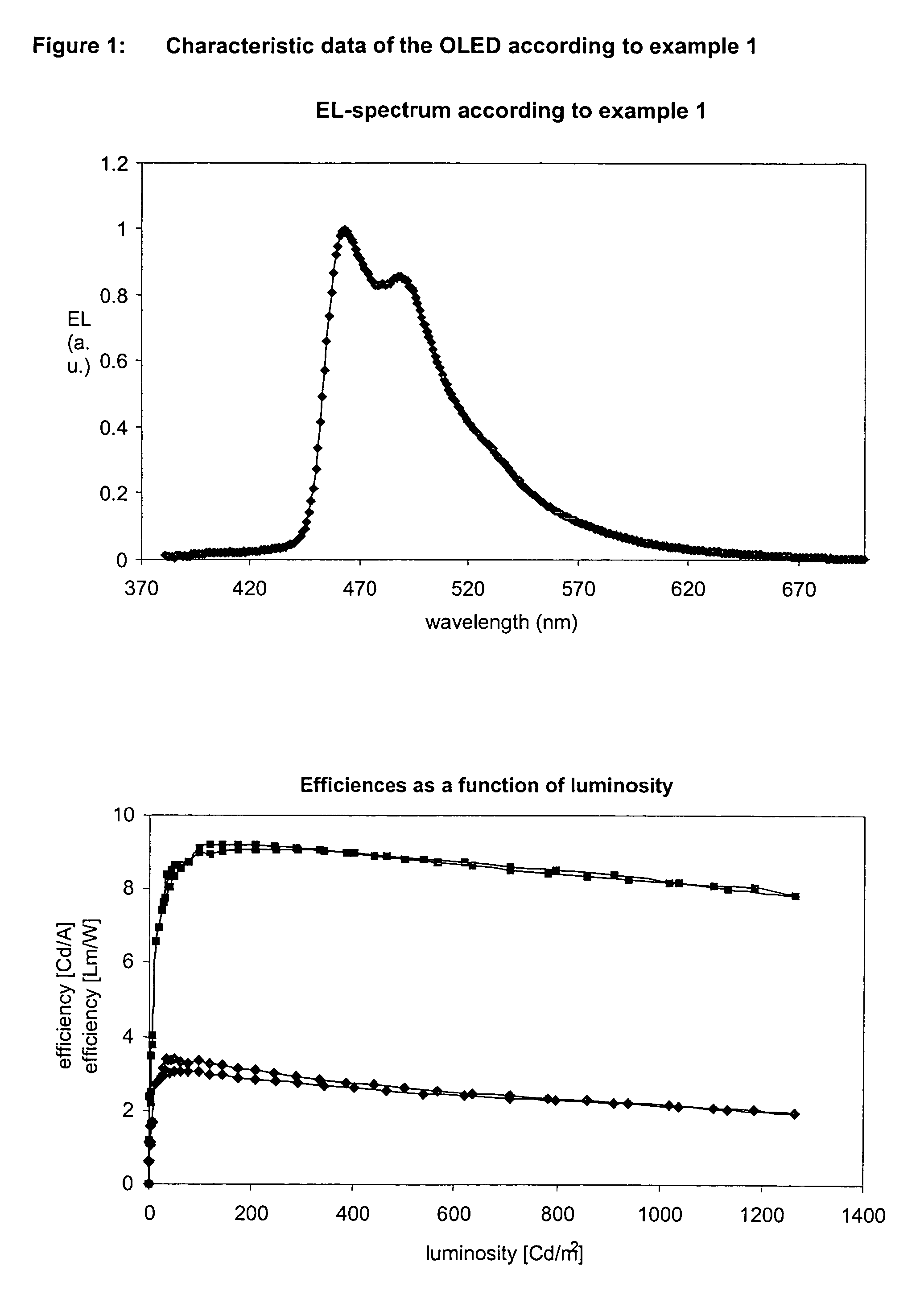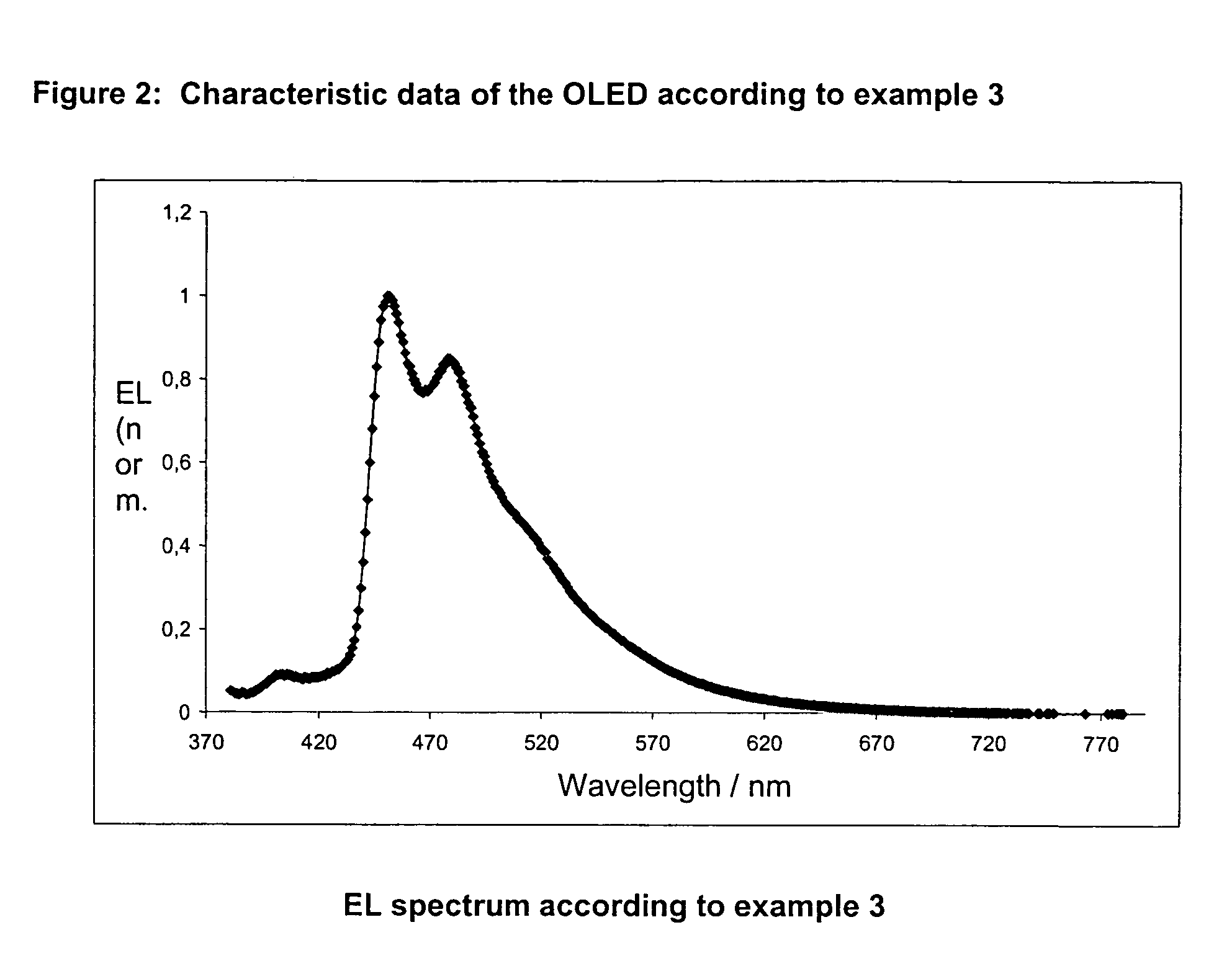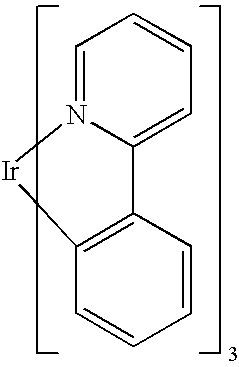Rhodium complexes and iridium complexes
a technology of iridium complexes and complexes, which is applied in the field of rhodium complexes and iridium complexes, can solve the problems of large power inputs, inability to achieve high luminosities in practice, and inability to meet the requirements of phosphorescence emitters based on tris-orthometallised iridium complexes. large, portable device power consumption
- Summary
- Abstract
- Description
- Claims
- Application Information
AI Technical Summary
Problems solved by technology
Method used
Image
Examples
example 1
fac-tris[2-(2-pyridinyl-□N)(5-cyanophenyl)-□C]-iridium(III)
Method A: Use of a Cyanisation Agent 1
[0068]A suspension of 8.915 g (10 mmol) fac-tris[2-(2-pyridinyl-□N)(5-bromphenyl)-□C]-iridium(III) and 5.374 g (60 mmol) copper(I)cyanide in 150 ml NMP was heated to 145° C. for 60 h. After cooling, the brown solution was poured all at once into a well-stirred, 50° C. hot solution of 7.4 g sodium cyanide in a mixture of 500 ml water and 500 ml ethanol and stirred for 2 h at 50° C. The microcrystalline deposit was then filtered off (P4). The microcrystalline yellow deposit was washed three times with, in each case, 100 ml of a solution of 7.4 g sodium cyanide in a mixture of 500 ml water and 500 ml ethanol, three times with, in each case, 100 ml of a mixture of ethanol and water (1:1, v v) and then twice with 100 ml ethanol and then dried in a vacuum (60° C., 10−4 mbar). The yield—with a purity of >99.0% according to 1H-NMR—amounted to 7.094-7.236 g corresponding to 97.2-99.1%.
Method B: U...
example 2
fac-tris[2-(2-pyridinyl-□N)(4-fluor-5-cyanophenyl)-□C]-iridium(III)
Method A: Use of a Cyanisation Agent 1
[0072]A suspension of 9.455 g (10 mmol) fac-tris[2-(2-pyridinyl-□N)(4-fluor-5-bromphenyl)-□C]-iridium(III) and 5.374 g (60 mmol) copper(I)cyanide in 200 ml NMP was heated to 160° C. for 60 h.
[0073]For preparation, see example 1, method A. The yield—with a purity of >99.0% according to 1H-NMR—amounted to 7.638-7.710 g corresponding to 97.5-98.4%.
[0074]1HNMR (DMSO-d6): [ppm]=8.46 (d, 1 H, 4JHF=6.4 Hz, H6′), 8.40 (br. d, 1 H, 3JHH=8.3 Hz, H6), 8.01 (br. dd, 1 H, 3JHH=8.3 Hz, 3JHH=7.5 Hz, H5), 7.48 (br. d, 1 H, JHH=5.6 Hz, H3), 7.33 (br. dd, 1 H, 3JHH=7.5 Hz, 3JHH=5.6 Hz, H4), 6.37 (d, 1 H, 3JHF=10.05 Hz, H3′).
example 3
fac-tris[2-(2-pyridinyl-□N)(4,6-difluor-5-cyanophenyl)-□C]-iridium(III)
Method A: Use of a Cyanisation Agent 1
[0075]A suspension of 9.635 g (10 mmol) fac-tris[2-(2-pyridinyl-□N)(4,6-fluor-5-bromphenyl)-□C]-iridium(III) and 5.374 g (60 mmol) copper(I)cyanide in 200 ml NMP was heated to 160° C. for 60 h.
[0076]For preparation, see example 1, method A. The yield—with a purity of >99.0% according to 1H-NMR—amounted to 7.638-7.710 g corresponding to 97.5-98.4%.
[0077]1HNMR (DMSO-d6): [ppm]=8.46 (br. d, 1 H, 3JHH=8.2 Hz, H6), 8.21 (br. dd, 1 H, 3JHH=8.2 Hz, 3JHH=7.0 Hz, H5), 7.47 (br. d, 1 H, 3JHH=5.8 Hz, H3), 7.30 (br. dd, 1 H, 3JHH=7.0 Hz, 3JHH=5.8 Hz, H4), 6.32 (dd, 1 H, 3JHF=10.05 Hz, 5JHF=1.35 Hz H3′).
PUM
| Property | Measurement | Unit |
|---|---|---|
| Ratio | aaaaa | aaaaa |
| Molar ratio | aaaaa | aaaaa |
Abstract
Description
Claims
Application Information
 Login to View More
Login to View More - R&D
- Intellectual Property
- Life Sciences
- Materials
- Tech Scout
- Unparalleled Data Quality
- Higher Quality Content
- 60% Fewer Hallucinations
Browse by: Latest US Patents, China's latest patents, Technical Efficacy Thesaurus, Application Domain, Technology Topic, Popular Technical Reports.
© 2025 PatSnap. All rights reserved.Legal|Privacy policy|Modern Slavery Act Transparency Statement|Sitemap|About US| Contact US: help@patsnap.com



